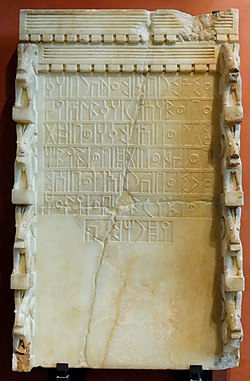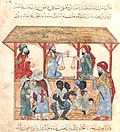Portal:Yemen
Yemen Portal


Yemen, officially the Republic of Yemen, is a country in West Asia. Located in southern Arabia, it borders Saudi Arabia to the north, Oman to the northeast, the south-eastern part of the Arabian Sea to the east, the Gulf of Aden to the south, and the Red Sea to the west, sharing maritime borders with Djibouti, Eritrea, and Somalia across the Horn of Africa. Covering roughly 455,503 square kilometres (175,871 square miles), with a coastline of approximately 2,000 kilometres (1,200 miles), Yemen is the second largest country on the Arabian Peninsula. Sanaa is its constitutional capital and largest city. Yemen's estimated population is 34.7 million, mostly Arab Muslims. It is a member of the Arab League, the United Nations, the Non-Aligned Movement and the Organisation of Islamic Cooperation.
Owing to its geographic location, Yemen has been at the crossroads of many civilisations for over 7,000 years. In 1200 BCE, the Sabaeans formed a thriving commercial kingdom that colonized parts of modern Ethiopia and Eritrea. In 275 CE, it was succeeded by the Himyarite Kingdom, which spanned much of Yemen's present-day territory and was heavily influenced by Judaism. Christianity arrived in the fourth century, followed by the rapid spread of Islam in the seventh century. From its conversion to Islam, Yemen became a center of Islamic learning, and Yemenite troops played a crucial role in early Islamic conquests. Much of Yemen's architecture survived until modern times. For centuries, it became a primary producer of coffee exported in the port of Mocha. Various dynasties emerged between the 9th and 16th centuries. During the 19th century, the country was divided between the Ottoman and British empires. After World War I, the Kingdom of Yemen was established, which in 1962 became the Yemen Arab Republic (North Yemen) following a coup. In 1967, the British Aden Protectorate became the independent People's Democratic Republic of Yemen (South Yemen), the first and only officially socialist state in the Arab world. In 1990, the two Yemeni states united to form the modern Republic of Yemen, with Ali Abdullah Saleh serving as the first president until his resignation in 2012 in the wake of the Arab Spring.
Since 2011, Yemen has been enduring a political crisis, marked by street protests against poverty, unemployment, corruption, and President Saleh's plan to amend Yemen's constitution and eliminate the presidential term limit. By 2015, the country became engulfed by an ongoing civil war with multiple entities vying for governance, including the Presidential Leadership Council of the internationally recognized government, and the Houthi movement's Supreme Political Council. This conflict, which has escalated to involve various foreign powers, has led to a severe humanitarian crisis.
Yemen is one of the least developed countries in the world, facing significant obstacles to sustainable development, and is one of the poorest countries in the Middle East and North Africa. In 2019, the United Nations reported that Yemen had the highest number of people in need of humanitarian aid, amounting to about 24 million individuals, or nearly 75% of its population. As of 2020, Yemen ranked highest on the Fragile States Index and second-worst on the Global Hunger Index, surpassed only by the Central African Republic. As of 2024, Yemen is regarded as the world's least peaceful country by the Global Peace Index. Additionally, it has the lowest Human Development Index out of all non-African countries. Yemen is one of the world's most vulnerable countries to climate change and among the least prepared to handle its effects. (Full article...)
Selected article -

The ancient history of Yemen or South Arabia is especially important because it is one of the oldest centers of civilization in the Near East. Its relatively fertile land and adequate rainfall in a moister climate helped sustain a stable population, a feature recognized by the ancient Greek geographer Ptolemy, who described Yemen as Eudaimon Arabia (better known in its Latin translation, Arabia Felix) meaning Fortunate Arabia or Happy Arabia. Between the eighth century BCE and the sixth century CE, it was dominated by six main states which rivaled each other, or were allied with each other and controlled the lucrative spice trade: Saba', Ma'īn, Qatabān, Hadhramaut, Kingdom of Awsan, and the Himyarite Kingdom. Islam arrived in 630 CE and Yemen became part of the Muslim realm.
The centers of the Old South Arabian kingdoms of present-day Yemen lay around the desert area called Ramlat al-Sab'atayn, known to medieval Arab geographers as Ṣayhad. The southern and western Highlands and the coastal region were less influential politically. The coastal cities were however already very important from the beginning for trade. Apart from the territory of modern Yemen, the kingdoms extended into Oman, as far as the north Arabian oasis of Lihyan (also called Dedan), to Eritrea, and even along coastal East Africa to what is now Tanzania. (Full article...)
List of selected articles
|
|---|
Selected biography -
The Queen of Sheba, also known as Bilqis in Arabic and as Makeda in Geʽez, is a figure first mentioned in the Hebrew Bible. In the original story, she brings a caravan of valuable gifts for Solomon, the fourth King of Israel and Judah. This account has undergone extensive elaborations in Judaism, Ethiopian Christianity, and Islam. It has consequently become the subject of one of the most widespread and fertile cycles of legends in West Asia and Northeast Africa, as well as in other regions where the Abrahamic religions have had a significant impact.
Modern historians and archaeologists identify Sheba as one of the South Arabian kingdoms, which existed in modern-day Yemen. However, because no trace of her has ever been found, the Queen of Sheba's existence is disputed among some historians. (Full article...)
General images -
Selected city -
Mukalla, officially the Mukalla City District, is a seaport and the capital city district of Yemen's largest governorate, Hadhramaut. The city is in the southern part of the Arabian Peninsula on the Gulf of Aden, on the shores of the Arabian Sea, about 480 kilometres (300 miles) east of Aden. It is the most important port city in the Hadhramaut region. It is also the sixth-largest city in Yemen, with a population of approximately 595,000 as of 2023. The city is served by the nearby Riyan International Airport. (Full article...)
List of selected cities
|
|---|
Selected picture -
Selected cuisines, dishes and foods -
Bint al-sahn (Arabic: بنت الصحن, romanized: Bint as-Saḥn, lit. 'daughter of the plate'), also known as sabayah, is a Yemeni pastry made from a dough, which is prepared by mixing white flour, eggs, yeast and clarified butter, known as samn (سمن). It is baked in multiple layers and typically served with honey and sprinkled with habbat as sowda (Nigella sativa, black cumin). (Full article...)
Related portals
Religions in Yemen
Arab states
Related portals
Categories
Topics
Related portals
Religions in Yemen
Arab states
Related portals
Associated Wikimedia
The following Wikimedia Foundation sister projects provide more on this subject:
-
Commons
Free media repository -
Wikibooks
Free textbooks and manuals -
Wikidata
Free knowledge base -
Wikinews
Free-content news -
Wikiquote
Collection of quotations -
Wikisource
Free-content library -
Wikiversity
Free learning tools -
Wiktionary
Dictionary and thesaurus
More portals











































































